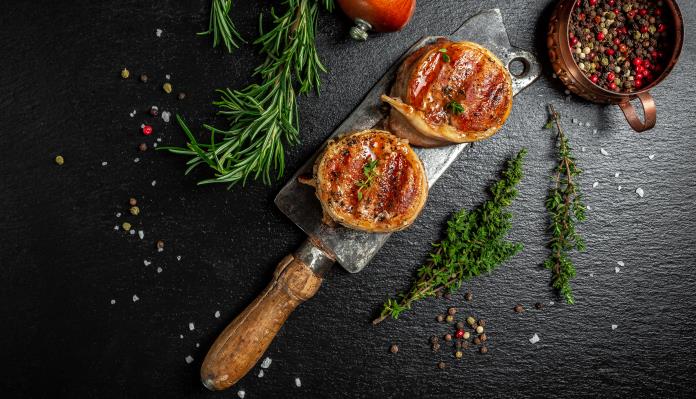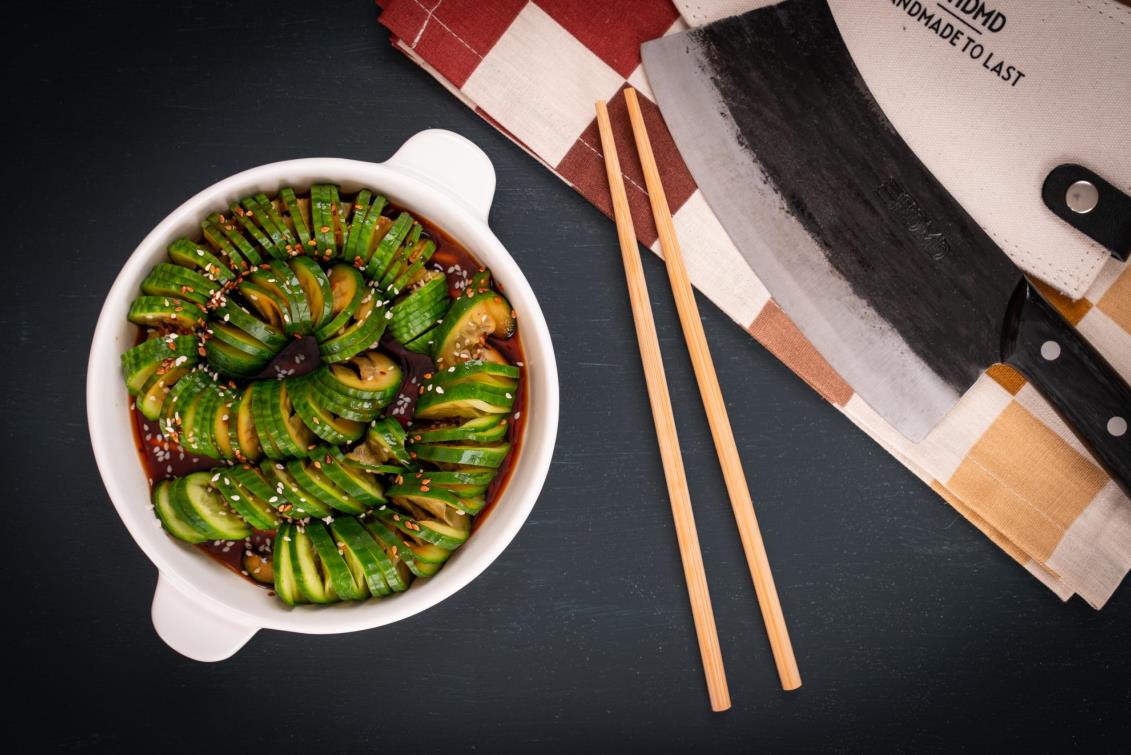Any sumptuous dinner starts with the main dish, and for many, that means beef. Beef is rich in flavor and nutrients, especially protein and iron. It’s a delicious option with varied cooking methods to fit any occasion. However, when perusing the butcher counter or meat section at the grocery store, it’s possible to feel overwhelmed by all the beef cuts available.
When cutting beef, the butcher breaks it down into primal cuts and then further into subprimal cuts. The butcher can then proceed to cut steaks, roasts, and other popular retail cuts from the subprimal. USDA recognizes four primal beef cuts: chuck, round, rib, and loin. However, other beef primal breakdowns include brisket, sirloin, plate, flank, and shank.
To help you better understand your options, we’ve put together a guide that explains the different beef cuts. This guide will also explain the flavors, textures, and different cooking methods ideal for each cut.
Table of contents
Knives to use when cutting beef

The process of cutting beef starts with the primal cuts. To make the primal cuts, the butcher will use a bandsaw. However, you don’t need a bandsaw to cut beef at home.
Several different knives can come in handy, depending on the final product you’re looking to create. Below are some of the most common knives used to cut beef:
Chef’s knife
A chef’s knife is a versatile option that suits many tasks in the kitchen, including cutting beef. The knife features a long, sharp blade that tapers to a point. While you can use a chef’s knife to create thin slices, it’s also ideal for larger tasks like cutting steaks from a roast.
Our Serbian Chef’s knife is an excellent option for general kitchen tasks, including cutting beef. The knife features a durable high-carbon steel blade and an ergonomic handle for a comfortable grip. It possesses the ruggedness of a true chef’s knife with the rigidity and heft necessary for chopping and slicing meats.
Cleaver
A cleaver is a heavy-duty knife designed for cutting through tough meat and bone. Cleavers are among the most popular knives used in butcher shops. The large, rectangular blade can make quick work of primal cuts. You can also use a cleaver to hack beef into smaller pieces, like stew meat.
Boning knife
A boning knife has a long, sharp blade that tapers to a point. The blade is narrower and more flexible than a chef’s knife, making it ideal for removing bones from cuts of beef. It’s the most suitable knife for cutting filet mignon, a steak cut from the tenderloin primal.
Handpicked for you
True cutting power in the palm of your hand
Beef cuts and recommended cooking methods

Before butchering the beef into primal cuts, the first thing butchers do is divide the cow into two main sections: the front quarter and the hindquarter. Butchers do this by dividing the cow between the 12th and 14th rib.
The front quarter of the cow includes the chuck, rib, brisket, and beef plate. The hindquarter contains the loin, flank, and round. Each section has different muscles that produce beef cuts with unique flavors and textures.
Below is a detailed explanation of where you can find each of these parts, how it appears, and the best way to cook them
Beef chuck

The chuck is the part behind the cow’s head. It consists of a section of the cow’s neck, upper arm, and shoulder blade. The chuck is a well-exercised area of the cow, so the muscles are tough. It also contains a lot of connective tissue and fat, which adds flavor but makes the meat less tender.
You can find two types of chuck cuts: boneless and bone-in. Boneless chuck is ideal for stews, pot roasts, and other dishes that require slow cooking to tenderize the meat. Bone-in chuck is best suited for braising or smoking. Because of the high fat content, it’s also an excellent cut for ground beef.
Separating the chuck from the rib happens at the 6th rib. As such, a section of the chuck will still have the longissimus dorsi muscle, a tender and flavorful part of the cow, also responsible for rib eye steak.
Avoid cooking chuck cuts using dry heat methods, like grilling or roasting. These methods will toughen the meat and make it less enjoyable to eat.
Rib

The rib primal is the part of the cow between the chuck and loin. It contains ribs six through 12 and is directly above the beef plate. The rib primal is one of the most flavorful sections of the cow because it includes some of the tastiest and most marbled cuts.
Some of the most well-known cuts come from the rib, including rib eye and prime rib. Beef ribs are also a popular cut for smoking and barbecuing. Notably, the traditional standing rib roast is a cut from the rib primal.
One of the best things about beef ribs is that you can cook them using dry or wet heat methods. Dry heat methods, like grilling and roasting, will produce tender, juicy meat with a crispy exterior. The cut is already tender, so you don’t have to worry about tough beef.
Brisket

Although tough, the brisket is one of the most flavorful parts of the cow. It’s a large, rectangular cut located directly below the chuck in the front primal.
The brisket contains two types of muscle: the leaner pectoralis profundus and the fattier pectoralis superficialis. The brisket area is around the cow’s breastbone and does a lot of work, so the muscles are tough.
However, it contains a relatively high-fat content, which makes it an excellent cut for smoking and barbecuing. The meats appear grained and coarsely textured but are somewhat tender when cut across the grain. If pot roasting or braising, cook the beef until it’s fork-tender.
Loin

The loin area is the most tender part of the cow. It’s also the most divided, containing various cuts, including the short loin, tenderloin, top sirloin, bottom sirloin, and sirloin.
The short loin is the section between the rib and the sirloin. It contains two of the most tender and popular cuts: the T-bone and Porterhouse steak.
The tenderloin is a long, thin muscle above the top sirloin and partly extends into the short loin. Butchers often remove the tenderloin and sell it as a separate cut. It’s the most tender part and is ideal for grilling, roasting, or sautéing.
The sirloin is the large area between the short loin and the round. It’s a leaner cut with less fat, making it ideal for grilling, roasting, or sautéing. The top sirloin is the most tender part of the sirloin and appears right below the tenderloin, whereas the bottom sirloin is a tougher cut.
Tri tip
The tri tip is a triangular cut from the bottom sirloin. It’s a lean, flavorful cut with minimal fat content. This part is a muscular cut, so it can be tough and is best suited for slow-cooking methods, such as braising or stewing. Before cooking, ensure you cut the tri tip across the grain for a more tender eating experience.
Round
The round primal is the large, muscular rear end of the cow. This part is available in different cuts, including the top round, bottom round, the eye of round, and tip. The meat from this area is lean with little fat content. However, it can be tough because the muscles do a lot of work.
The top round gives us some of the most popular cuts, including London broil, roast beef, and steak. The bottom round is the least tender and is often sold as stew meat or used for ground beef. However, it also makes excellent roast beef.
The top and bottom rounds don’t contain much collage. Slow roasting or braising is the best way to tenderize these cuts and make them juicy. But if you’re planning to grill or pan-fry the meat, you should look for cuts from the eye of round or tip, which are more tender.
Flank

The flank primal is the part of the cow between the loin and the belly. The flank is a long, thin, relatively tough, lean muscle. The best way to tenderize the flank is to marinate it before cooking. Flank steak is the most popular cut from this area and is popular in Mexican and Asian dishes.
Flat iron steak is another popular cut from the flank. It’s a little more tender than flank steak and has a higher fat content, making it juicier. Cut the flank steak against the grain, which can be just as tender as a filet mignon. Avoid overcooking any flank part, or it will become dry and tough.
Bottom Line
There you have it – a detailed guide to different beef cuts. We hope that from this guide, you’ll be able to choose the right beef cut for your needs and have a delicious and satisfying experience. As with all meats, the quality of the beef will also play a role in the taste and tenderness. So ensure that you buy from a reputable butcher or grocery store.
Knowing what beef cut to choose is one thing, and having the tools for the perfect steak experience is another. Visit our shop for the perfect handmade knives to accompany your next steak dinner. Remember to check our other blog posts for more interesting guides and tips.












